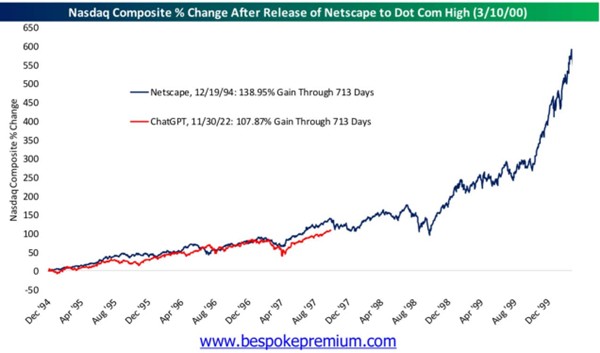
 I follow an X/Twitter account that regularly posts the following chart, updating it frequently.
I follow an X/Twitter account that regularly posts the following chart, updating it frequently.
The chart compares the Nasdaq’s performance — between Netscape’s 1994 release and the year 2000 (dot-com bubble peak) — with its performance since ChatGPT’s launch (red) in late November 2022.

Netscape’s release in December of 1994 marked the beginning of the Internet age.
ChatGPT was released on November 30th, 2022, marking the beginning of the investable artificial intelligence (AI) age.
On December 5th, 1996, Federal Reserve Chairman Alan Greenspan coined the phrase irrational exuberance as the dot-com bubble grew, warning investors that the market may be overvalued.
It took another three+ years for the bubble to burst.
I raise this now because notable market valuation metrics like the Shiller PE and the Buffett Indicator are signaling an overvalued market.
But pundits, banks, and tech leaders argue it isn’t.
Massive investments in AI infrastructure are only beginning as the Mag 7 companies and their bulletproof balance sheets invest capital to avoid falling behind in the age of AI.
Retail investors have widespread access to stocks and other assets at their fingertips.
Compared to 1999, there are far more investors and dollars feeding the market.
Meanwhile, there are fewer public companies to invest in (about 4,300 stocks, compared to about 7,300 in 1996) now that startups are staying private longer.
A handful of market leaders, including Nvidia, Oracle, Meta, Alphabet, and Microsoft, are driving index gains, and these companies are investing their balance sheets into AI infrastructure.
Furthermore, startups like OpenAI and Anthropic are attracting venture capital and investing in infrastructure.
Nobody can predict market tops or bottoms; we can only ride the wave. But long-term, the market’s history is compelling.
And that’s why DIY investors should stay the course, dollar-cost averaging into the market through employer accounts or regular investments in a Roth or IRA.
Those who need cash for short-term spending (1-2 years) should keep it in cash in case of a market event.
It may be tempting to become cautious or try to anticipate a crash and go into cash, but as famed mutual fund manager Peter Lynch said in September 1995:
Far more money has been lost by investors in preparing for corrections or anticipating corrections than has been lost in the corrections themselves.
History doesn’t repeat exactly, but it often rhymes — and for patient investors, that rhythm still favors those who stay invested through every cycle.
Featured image via Deposit Photos used under license.
Favorite tools and investment services (Sponsored):
Boldin — Spreadsheets are insufficient. Build financial confidence. (review)
ProjectionLab — Build financial plans you love. (review)
Empower — Free net worth and portfolio tracking + retirement planning. User since 2015.
Sure Dividend — Research dividend stocks with free downloads (review):






